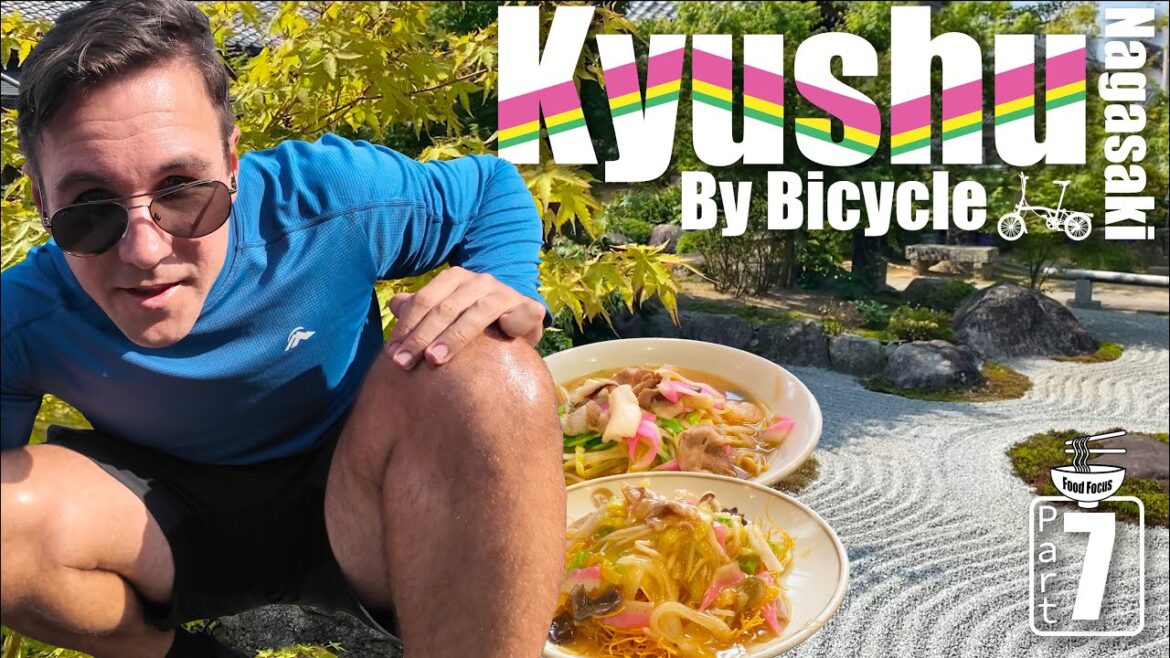Kyushu Bike Adventure 7 – Nagasaki
The food at last night’s izakaya was on another level. And the toilet jazz, well, I’ll let you make your own mind up about that. Yesterday, we dove into 19th century Nagasaki with Thomas Lover, but today we’re going way back to the 17th century. It doesn’t look like much of an island now, but when constructed in 1636, Dejima, Portugal’s man-made island, sat off the coast of Nagasaki. The Portuguese got kicked out in 1639. And the Tokugawa shogunit said, “Dutch only, but only on this 190 m long island.” Not so much as a European tow on the mainland, thanks. It’s crazy to think that all European trade with Japan flowed through this tiny island for more than 200 years. It was Japan’s only connection to Europe and Europe’s only connection to Japan. Today, Dejima has been enveloped by the city as it expanded into Nagasaki Bay with land reclamation projects throughout the centuries. The Chinese had their own spot too called Tojin Yoshiki, a world compound for traders. No trace of it now though as it’s completely lost to time. But still Chinese influence can be felt throughout the city. Case in point, Nagasaki’s Chinatown, just a short walk from Djima. And that’s where we’re headed today for this episode’s Takarat because history is never dull when you get to eat it. Today it’s Shipoku style Chinese Japanese fusion. Taka, you’re lucky boy. So, I’ve come to Nagasaki’s Chinatown for more of this Shipoku cuisine. And I had some just the other day with the Turkish rice. And here I’m at a Chinese restaurant. I’m eating some Sara udon and some Champon. Now, these cuisines, like the Turkish rice, is this kind of fusion cuisine, and it hints at the history here. So, the Sara udon is this blend of Chinese influences with this kind of what Americans might call chopsie. It’s like a stir fried vegetables over crispy noodles and then this thick stodgy sauce on top. Nice and savory, crispy and soft. On top, you’ve got cabbage, you’ve got pork, you’ve got fishcake, prawns, black fungus, bean shoots, and onions. They look like muscles. the clams. So, it’s all kind of mish mashed together and these crispy noodles as well, which go kind of soft pretty quickly in this stodgy, thick, savory sauce. So, it has some similarities to what I think of as Chinese cuisine in Australia. It’s like eastern seabboard Chinese flavors. We go to the local Chinese restaurant and have those kind of stir- fried dishes with noodles. has some of those vibes, especially the use of corn flour to thicken up that sauce. And the sauce, it doesn’t have a strong flavor. Has a mild garlic savory flavor. So, the Turkish rice was showing the influences from Turkey and Europe and Japan. This is more Japan and China. And I think the Sarah udon actually evolved from the Champon, which is more like a ramen. So, let’s get to that. Now, if you look at it, it’s like a thin rameny broth. In fact, there’s some similarities with this to ramen. Looks a lot more hearty, easygoing. Bunch of noodles. Lots of similarities with the sor udon. Got lots of the same ingredients. You’ve got the seafood. You’ve got the pork. You’ve got the fishcake, prawns, fungus. In fact, it’s very, very similar. So, you can see that direct correlation between the two dishes. And then you’ve got these noodles, which are not ramen noodles. They’re much more like a hoken noodle. Got that kind of bite to them. Let’s try the broth. So much lighter than ramen, but a really full savory flavor. It’s very easy eating. And then you’ve got octopus, prawn, cabbage, noodles, and that broth. Definitely gentler on the palette than tonkatsu, but also much less rich as well. Much less heavy. This is actually quite a light noodle soup. Decent Nagasaki fusion fair. I do like it more than the Turkish rice, if I’m to be honest. As we’ve seen from the Shipoku cuisine, Turkish rice, Sara udon, and Champon to Jokichi Kasano’s western restaurants, Nagasaki has been Japan’s window to the world for centuries. It’s got a vibe like nowhere else. I just love it. But the show must go on. And tomorrow, I’m heading north to II. Expect a surprise breakfast, a pottery town, some famous Imari beef, and yeah, my fold is back in action. Want to come along? Don’t be shy. Hit the button and let’s keep this ride riding. [Applause] [Music] [Applause] [Music]
Flying from Jakarta Indonesia to Fukuoka Japan for a bicycle tour on a Brompton folding bike. Expect to see Fukuoka, Nagasaki, Kitakyushu, Miyazaki, Kagoshima, Kumamoto and plenty of towns in between. I ride, I eat, I ride, I eat, I rinse, I repeat. 18 episodes. Ramen, gyoza, onigiri, miso black cod, Imari beef, Takuro rice, kushiyaki, sashimi, combini, okonomiyaki, sushi, yakitori, yakiniku, tonkatsu, tonkotsu, tempura, soba, udon, matsunabe, sake, keiseki, not gonna lie, I do a lotta eating.
Dream Big:
Music: https://www.bensound.com
License code: H2ELJPTQ2SQTOXVN
@Japan @Kyushu @Ramen @gyoza @onigiri @miso black cod @Imari beef @Takuro rice @kushiyaki @sashimi @combini @okonomiyaki @sushi @yakitori @yakiniku @tonkatsu @tonkotsu @tempura @soba @udon @matsunabe @sake @keiseki @Fukuoka @Nagasaki @Kitakyushu @Miyazaki @Kagoshima @Kumamoto @drone @foldy @Brompton @bike @bicycle @biketour @oita @Imari @karatsu @kashima @isahaya @miyajidake @beppu @nakatsu @hells @azamui @saiki @nobeoka @takachiho @takachihogorge @sakurajima


AloJapan.com